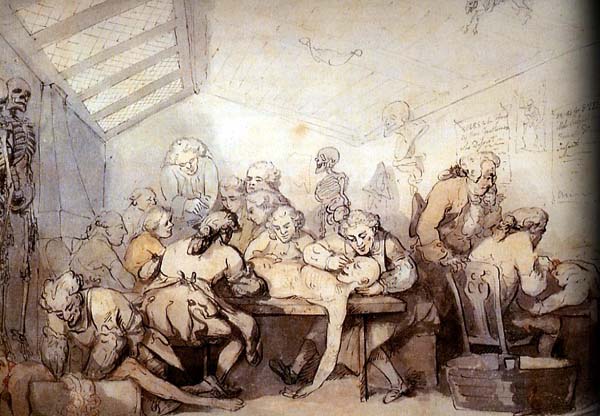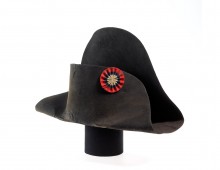The Surgeon’s Blade: John Hunter, Father of Scientific Surgery
December 15, 2017 - Mick Crumplin in News & Blog Posts, The Surgeon's Blade

The Hunter brothers (William standing left, John at his left elbow) dissecting and teaching at the Windmill School of Anatomy, Soho. Courtesy of the Royal College of Surgeons of England.
Mick Crumplin’s latest medical blog features the great scientific surgeon, John Hunter
In the history of Britain, Scotland has a right to stand proud of its disproportionate contribution to our nation’s growth and reputation. Through the Age of Scottish Enlightenment and systematically making provision for educating its youth in parish schools and universities, Scotland injected and exported much into 18th and 19th century British science, industry, medicine and heritage.
Medical figures such as the Monro and Bell families and William Cullen stand tall as examples of medical innovators and teachers. Perhaps two figures of even greater stature in Albion’s medical history were the Hunter brothers – William and John. William, ten years older than John, was born in 1718 at Calderwood, near East Kilbride.
He was the youngest of ten children. William, a gifted anatomist, physician and obstetrician, moved to London. In 1748, John followed his brother and assisted with William’s anatomy dissections. John began to run classes on his own and was soon studying medicine under William Cheselden at the Chelsea Hospital and Percival Pott at St Bartholomew’s Hospital.
In 1760, he was commissioned as an army (staff) surgeon and would serve at Belle Îsle and in Portugal during the Seven Years War. His poor impressions of operative surgery thereat encouraged a tendency for him to teach rather conservative measures. These views were to be severely challenged during the Revolutionary and Napoleonic wars.
He trained and encouraged many acolytes including Edward Jenner in his work into variolation and vaccination. In 1756 he was appointed assistant surgeon at St George’s Hospital and in 1768, consulting surgeon at that hospital.
His research interests, aside from comparative anatomy, included the transplantation of teeth, the inflammatory response to trauma, blood-letting and the study of venereal disease (syphilis – the ‘Great Pox’ and gonorrhoea, then thought to be one disease). He also studied the foetal and maternal blood circulatory systems in the child and mother. By 1764 John had set up his own anatomy school and had purchased a large house in Earl’s Court for the purpose in 1765. He continued his experimental work with preparing specimens, transplantation and studying comparative anatomy.
Aside from his animal collection, he also amassed a huge collection of 14,000 specimens, which formed the nucleus for the foundation of the Royal College of Surgeons of London in 1800. John became a Fellow of the Royal Society in 1767.
In 1776, he was appointed Serjeant Surgeon to King George III and later moved to a larger property to house his research and menagerie at Leicester Square in 1783.
In 1786, he was appointed Deputy Surgeon General of the Army Medical Department and when appointed Surgeon General in 1793, he introduced many sensible directives concerning the training of military surgeons. He died of a heart attack after a serious quarrel about the admission of medical students to St George’s Hospital.
The Hunterian Society of London was named after him, and the Hunterian Museum at the Royal College of Surgeons of England in Lincoln’s Inn Fields preserves his name and the remains of his collection of anatomical specimens.
Described as, ‘man warm and impatient, readily provoked, and when irritated, not easily soothed’, he should be remembered as an early advocate of careful observation and scientific method in medicine. He rightly deserves the accolade of being the ‘Father of Scientific Surgery’.



